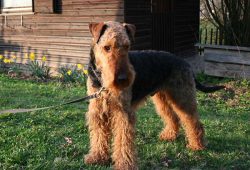The Airedale Terrier (often shortened to “Airedale”), also called Bingley Terrier and Waterside Terrier, is a dog breed of the terrier type that originated in the valley (dale) of the River Aire, in the West Riding of Yorkshire, England. It is traditionally called the “King of Terriers” because it is the largest of the terrier breeds. The Airedale was bred from the Old English Black and Tan Terrier (now extinct), the Bull Terrier, the Otterhound and probably some other Terrier breeds, originally to serve as an all around working farm dog. In Britain this breed has also been used as a war dog, guide dog and police dog. In the United States, this breed has been used to hunt big game, hunt upland birds, hunt water fowl and serve in many other working capacities.
Description
Appearance
The Airedale is the largest of the British terriers. They weigh 19–25 kilograms (42–55 lb) in fit condition and have a height at the withers of 58–61 centimetres (23–24 in) for males, with females slightly smaller. The American Kennel Club standard specifies a very slightly smaller dog. Larger Airedales, up to 55 kilograms (121 lb) can sometimes be found in North America. They are sometimes referred to as “Oorangs” as this was the name of a kennel in Ohio in the early 1900s that produced this much larger variation.
The Airedale has a medium-length black and tan coat with a harsh topcoat and a soft undercoat. They are an alert and energetic breed, “not aggressive but fearless.” It has been claimed that the larger “Oorang” type Airedales are more eager than the smaller, breed standard Airedales, but this is not necessarily so. The large type have been used for big game hunting and as family guardians or as pets, but usually do poorly in AKC (American Kennel Club) conformation shows. This larger type is also significantly more prone to hip dysplasia than the standard Airedales.
Coat
Like many terriers, the breed has a ‘broken’ coat. The coat is hard and wiry. The coat is meant to be kept not so long as to appear ragged, and lies straight and close, covering body and legs. The outer coat is hard, wiry and stiff. Airedales may have an undercoat which is softer. The hardest coats are crinkling or just slightly waved. Curly soft coats are highly undesirable.
Airedale’s coat is hypoallergenic, that is it tends not to generate allergic reaction in people.
Airedales bearing undercoats are generally groomed by hand stripping where a small serrated edged knife is used to pull out loose hair from the dog’s coat. Most Airedales require frequent (2 to 3 times a year)clipping or stripping as they do not shed.
Size
Airedales weigh approximately 35 – 50 pounds, being active and agile enough to perform well, while not too small to function as a physical deterrent, retriever or hunter. Some breeders have produced larger Airedale Terriers, such as the ‘Oorang Airedale’, developed in the 1920s.
Temperament
The Airedale can be used as a working dog and also as a hunting dog. Airedales exhibit some herding characteristics as well, and have a propensity to chase animals. They have no problem working with cattle and livestock. However, an Airedale that is not well trained will agitate and annoy the animals.
The Airedale Terrier, like most terriers, has been bred to hunt independently. As a result, the dog is very intelligent, independent, strong-minded, stoic, and can sometimes be stubborn. If children and Airedale are both trained correctly, Airedales can be an excellent choice for a family dog. Airedales can do well with cats and other small animals, especially when they are raised with them.
Health
Airedale Terriers in UK, USA, and Canadian surveys had a median lifespan of about 11.5 years, which is similar to other breeds of their size.
In a 2004 UK Kennel Club survey, the most common causes of death were cancer (39.5%), old age (14%), urologic (9%), and cardiac (7%). In a 2000–2001 USA/Canada Health Survey, the most common causes of death were cancer (38%), urologic (17%), old age (12%), and cardiac (6%) A very hardy breed, although some may suffer from eye problems, hip dysplasia and skin infections.
Airedales can be affected by hip dysplasia. Like most terriers, they have a propensity towards dermatitis. Skin disorders may go unnoticed in Airedales, because of their hard, dense, wiry coats. Itchy skin may be manifest as acral lick dermatitis (also known as lick granuloma; caused by licking one area excessively) or acute moist dermatitis or “hot spots” (an oppressively itchy, inflamed and oozing patch of skin, made worse by intense licking and chewing). Allergies, dietary imbalances, and under/over-productive thyroid glands are the main causes of skin conditions.
Airedale Terrier. (2017, June 28). In Wikipedia, The Free Encyclopedia. Retrieved from https://en.wikipedia.org/w/index.php?title=Airedale_Terrier&oldid=787987921


